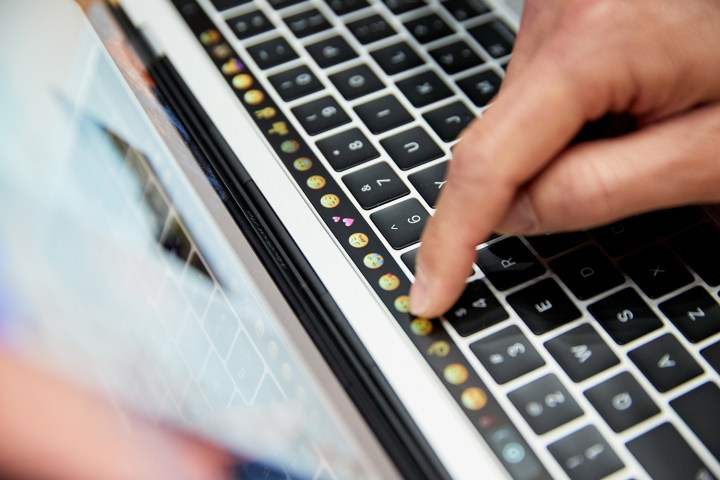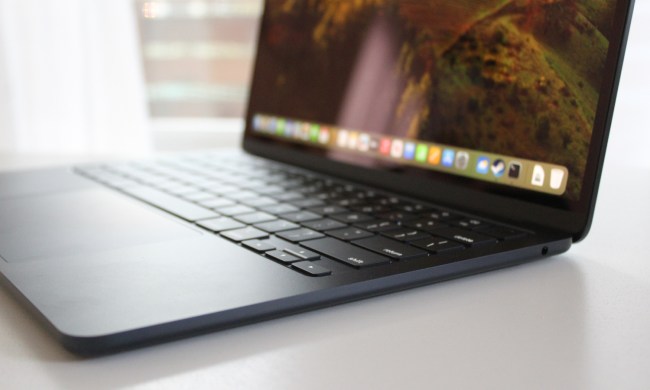
However, this is only one small step in a larger overhaul of the traditional laptop keyboard — a process that’s already been in the works for some time.
Butterflies and Hurricanes
In March 2015, Apple showcased a brand-new iteration of its MacBook at one of the company’s trademark special events. Senior vice president of worldwide marketing Phil Schiller took to the stage to stress the many merits of the new product. Little more than a minute into his address, he started detailing “one of its most dominant features” — its keyboard.
Not only was the size of the new MacBook determined by the width of its keyboard, but Apple’s engineering staff had gone back to basics to perfect the feeling of each keystroke. Slow-motion video demonstrated the flaws of the previous Scissor mechanism, which the brand-new Butterfly design would stamp out.
The MacBook’s keyboard may have been Apple’s attempt at a blank canvas.
The Butterfly mechanism — which is present in the new MacBook Pro, albeit in an updated second-generation form — possesses several major benefits over its predecessor. It allows the keyboard to be 40 percent thinner, it’s built with a single assembly, and it switches out the Scissor’s silicone dome switch for a stainless-steel construction.
Schiller told attendees and Apple enthusiasts watching the live stream that the new mechanism would allow the MacBook keyboard to be more precise and accurate than ever before.
For all of Apple’s bluster about its new keyboard, critical response was mixed. Some reviewers grew to love the new mechanism, while others were left cold. Digital Trends’ Matt Smith described it as “a brilliant solution to a problem that arguably doesn’t need to exist.”
But what if Apple wasn’t trying to deliver the “perfect” keyboard back in 2015? Perhaps the company was instead building a new, blank canvas. Perhaps the goal is to design a keyboard that can be used as a firm foundation, underpinning innovations scheduled for the coming years.
Flexible Functionality
This week, Apple announced that the new MacBook Pro will ditch its traditional row of function keys for an OLED strip, dubbed the Touch Bar.
The idea is that the keys shown on the toolbar will be tailored to whatever action the user is performing at a given time. The keyboard — once completely stoic and stationary — is being given a little bit more flexibility to cater to the user.
This is a relatively minor edit, in the grander scheme of things. Function keys aren’t used anywhere near as much as the rows of standard keys on a keyboard, so the company has more freedom to tweak them without raising the ire of users. We won’t hear anywhere near as much outcry about physical function keys being ditched as we did when Apple removed the headphone port from the iPhone, for example.
That said, placing a row of context-sensitive keys on the keyboard of every new MacBook Pro will start to familiarize Apple users with the idea that individual keys can look different, and provide different functionality. For the first time, the laptop keyboard won’t simply be a static object. Even if can only do so with a few keys, it’s being given the ability to shape-shift. And that may just be the start.
Making Magic
Earlier this month, reports began to circulate that Apple was in talks to acquire an Australian startup called Sonder. The company is responsible for some interesting new advances in keyboard technology, placing E Ink displays underneath transparent plastic keys.
This means that the keyboard can display entirely different character sets on the fly, quickly switching between QWERTY and AZWERTY configurations, for instance.
A row of context-sensitive keys will familiarize Apple users with the idea that keys can look different.
It’s easy to see why this kind of technology would be well-suited to an Apple product. It’s intuitive for users, yet difficult for other companies to emulate, because it relies on close coordination of hardware and software features.
Apple’s GarageBand app has long since offered the option for the system keyboard to be used as a platform for ‘musical typing’ of notes and chords, but it can take getting used to. But imagine if your keyboard could instantly transform itself into classic black-on-white music notes, eliminating the confusion of pressing the G key to play a C note.
There are a few holes in the Sonder story that might suggest the deal isn’t as sure a thing as was initially thought. The company has now denied that its CEO met with Apple’s Tim Cook at an event last week, according to a report from The Verge.
Still, there’s no smoke without fire. The company’s CEO has been confirmed to be at the event in Beijing, which was apparently organized by Apple manufacturing partner, Foxconn. A Reddit post from a purported Sonder rep claims that the company “would very much like the opportunity” to meet with Cook in the future. And whether this specific meeting took place or not, the fact the interest is there suggests the idea is being explored.
Shift Key
Whether Apple ends up working with Sonder — or even pursuing an E Ink underlay — it seems that the keyboard is the next element of its computers due for a reboot.
Apple perfected its laptop monitor with the Retina display, first introduced to the MacBook Pro in 2012. This year, the company overhauled its OS X operating system with the release of MacOS. There’s not a great deal more that can be done to upgrade and enhance the MacBook without taking a stab at the keyboard.
Given that Apple has never been big on trumpeting internal components, what’s left to tweak on the MacBook now that attention has been given to its display and its OS? Changing up how users interact with the MacBook is the only way to go.
Looking back, Apple’s biggest success over the past fifteen years have been the iPod and the iPhone — two devices that took risks with their input method, and changed the landscape of their respective marketplaces. Compare those products to Apple TV and the Apple Watch, where the uninspired remote and the underutilized digital crown failed to make a similar impact.
Apple’s greatest strength is the ability to refresh familiar experiences with an injection of new technology, whether it’s listening to your favorite album, or making a telephone call. The keyboard just may be the next familiar, mundane technology touched by the company’s magic wand.

